GUINNESS CHOCOLATE CAKE & A LEMON PANTRY STAPLE
An Irish cake without the St. Patty's kitsch, and what to do with an excessive lemon sitch.
AU: HELLO AND HAPPY ST. PATRICK’S DAY! I love green (it’s my favorite color), and I love many Irish foods like soda bread, shepherd’s pie, colcannon, and Irish whiskey… but St. Patrick’s day ain’t really it for me, ya know? So that’s why I decided to do something with all of the lemons my lemon tree produced this year, instead.
EK: So like you, St. Patty’s Day is not my favorite holiday by far, but I do love Guinness and I do love a good Irish whiskey and it’s a good excuse to talk about both of those…
AU: I would say that no one I know is better equipped to discuss both of those subjects, than you, my dear! Spill the tea…
EK: Well, I am not just talking about drinking them. I am talking about baking my favorite chocolate cake: Double-Dutch Chocolate Guinness Bundt Cake. This holiday is as good an excuse as any to break out one of my super-fun Nordic Ware bundt pans and bake the cake. You can make it in any bundt pan, but a 12-cup Bundt pan is best. I used the 10-cup Jubilee pan because I love the shape but I had to bake a few muffins with the extra batter.
AU: I mean, a cake-muffin sampler platter does not sound like the worst thing in the world to me…
EK: But before we talk about the cake, I have to mention that I am excited for the new season of The Three Drinkers. This Amazon Prime show is a travelogue from drinks experts, writers and broadcasters Helena Nicklin and Aidy Smith. In the first season, they traveled to Scotland where they were joined by a revolving roster of ‘third drinker’ guests. Smith and Nicklin also produce the ‘Bring a Bottle’ podcast, and run the website thethreedrinkers.com (If you google them, make sure to type in the “the” because there is an Italian website called “three drinkers”).

In this year’s series, The Three Drinkers visit one of my favorite distilleries, Kilbeggan Distillery. When I visited Kilbeggan, I had the best time. I learned to bet on the horses and won money from every race that I bet on that night! I ended the evening dancing a jig to traditional Irish music at Larrigy’s Pub—and no surprise, there may have been a lot of Irish whiskey poured that night!
The distillery is the oldest continuously-licensed distillery in Ireland—since 1757— and it’s all good, but the Kilbeggan Single Grain whiskey is my favorite. Check out the show on Amazon Prime, and check out the whiskey. And, if you find yourself on Route 466 in the town of Kilbeggan, you must stop by the distillery and the pub!
EK: And now back to dessert, Double-Dutch Chocolate Guinness Cake with Chocolate Guinness Glaze
This recipe is from my cookbook, Steak & Cake and is my go-to chocolate cake. I love a good bundt and this is a very good bundt. It uses a whole cup of Dutch process cocoa to give it an almost coal-black color and a glaze to add a bit of extra sweetness and moisture to the dense butter cake. The Guinness has a special affinity with the dark chocolate and adds a depth of flavor without tasting boozy. A pinch of nutmeg is added to highlight the chocolate and the Guinness.
What’s the difference between Dutch Process and regular Cocoa? They are both unsweetened, pure cocoa powder. I prefer the look and taste of Dutch-Process for this cake, but I have both types of cocoa in my pantry.
Dutch-processed cocoa powder is associated with European cocoa powder. It is cocoa powder that has been washed in a potassium solution that neutralizes its acidity and bitterness. This is called the “Dutch-process.” It also gives the cocoa powder a very pleasing dark color—almost black. Guittard’s unsweetened cocoa is Dutch-process as is Droste cocoa powder and both are very good.
Natural “American” cocoa powder is cocoa that is not processed to remove the natural acid. Natural cocoa powder is lighter in color—reddish brown. Natural cocoa powder is what is typically sold by American companies such as [the original] Hershey’s Cocoa Powder and Toll House Cocoa Powder. Today, Hershey’s also makes a Special Dark Dutch-process cocoa powder.
This is a butter cake, and when you are making a butter cake, it’s essential that the butter is room temperature. I like to cream it first on it’s own until it’s light and fluffy. I then add the sugar and cream them together until they are light and fluffy together. Then I add room temperature eggs one by one to make a smooth creamy batter.
Egg hack/baking tip: If you forget to take them out of the refrigerator and bring them to room temp, don’t worry. You can place the eggs in a bowl with hot water, stirring occasionally for about 5-10 minutes to take the chill off. If the eggs are cold, that will sometimes cause the butter and sugar to clump together and the batter won’t be smooth.
When I wrote Steak & Cake, I eliminated the need to sift the flour and used a spoon and sweep method because a lot of people told me they didn’t bake cakes because they didn’t want to go through the extra steps of measuring and sifting.
I still use my sifter when I use cocoa powder or confectioners sugar because they both have a tendency to clump up as they sit in your pantry. And you don’t want any lumps in your batter.
The other thing that you need to know if you are using a bundt pan is that you need to prepare the pan with a lot of fat and flour. I like to use Baker’s Joy because it is in a spray can and you can really get into those nooks and crannies.I prefer Baker’s Joy over other similar products because it doesn’t have artificial scents/flavors added to it. If you prefer to make a similar paste yourself and brush it on, you may be interested in this article from The Seattle Times about making your own version of “brush-able” Baker’s Joy for “easy cake extraction…” which is a thing, believe me!
Double-Dutch Chocolate Guinness Cake with Chocolate Guinness Glaze
The glaze is an essential part of the cake as you poke holes in the cake when it is still warm and slowly spoon the glaze over the cake until the holes are filed with the glaze. That way, once the cake is cooled and sliced, each piece has rivets of deep chocolate glaze set into the top of the cake.
For anyone who is nervous that the cake will taste like beer, it does not. The Guinness adds a stouty richness that makes the cake the best chocolate cake you have ever eaten.
Serves 10-12
Cake Ingredients:
½ pound (2 sticks) unsalted butter, softened
2 ½ cups granulated sugar
4 large eggs
1 cup cocoa, preferably Dutch process
2 ½ cups all-purpose flour
½ teaspoon baking powder
½ teaspoon baking soda
½ teaspoon sea salt
Pinch of fresh ground nutmeg, about 1/8 th teaspoon
1 tablespoon vanilla
½ cup of half and half
½ cup of Guinness, room temperature
Pan: Traditional Bundt or Pound cake Pan (12-cup capacity)
Baker’s Joy
Cake Method:
Preheat oven to 325 F
Cream butter and sugar until fluffy. Add eggs one at a time and beat until thoroughly mixed.
In a large bowl, mix cocoa, flour, baking powder, salt and nutmeg with a whisk or a sifter.
In a liquid measuring cup, measure vanilla, half and half and Guinness and mix to combine.
Add dry ingredients alternatively with the liquid mixture, ending with the dry (flour) ingredients.
Bake 1 hour and 10 minutes to 1 hour and 25 minutes, or until a toothpick comes out clean. The baking time will vary based on your oven. I start testing with a toothpick after an hour and then every ten minutes after that until it comes out clean and the cake has receded from the sides.
Meanwhile, make the glaze and set it aside.
Chocolate Guinness Glaze Ingredients:
2 overflowing cups Confectioner’s Sugar
3 generous tablespoons Dutched cocoa
3 tablespoons Guinness
2 tablespoons half and half or cream
½ teaspoon vanilla
Pinch of fine-grain sea salt
Method:
Whisk or sift sugar and cocoa together and set aside.
Mix Guinness, half and half, vanilla and salt together.
Add the liquid ingredients to the dry ingredients and stir with a fork until completely mixed and smooth.
Finish the Cake:
Let cake cool on a rack in the pan for 5 minutes. Invert cake onto rack so that the top is positioned up.
Poke top all over with toothpick. Spoon glaze on top and wait until it seeps into the holes. Cover holes with more glaze until the holes are full and let set for 10 minutes or so. Pour remaining glaze over top of cake and let it run down the sides.
Let cool before slicing.
WHEN LIFE HANDS YOU LEMONS… PRESERVE THEM!
AU: I know Queen Bey wrote a whole album about making lemonade, but like… this is just better. It’s a way for your future self (let’s say in the dead of winter, or I dunno… a rude, mid-March snow flurry!) to thank your present self for having the forethought to pack some sunny flavors away in a jar. Like opening a Roth IRA in your fridge (this simile is a bridge too far)…
It all sounds verrrrry niche, chefy, and bougie… PRESERVING LEMONS… like something only Alice Waters would do. But I promise you it’s NOT all those things, and you absolutely should try it! It’s a great project to do with the kids, and it truly couldn’t be simpler.
You’re essentially going to pack as many lemons as you can into a clean jar with some salt and sugar (other spices are optional). Then just leave it for a month. Done.
As the salt cures the lemons, they release their juices, their rinds soften, and they take on this bitter/salty/sweet/umami taste. Ever had a delicious tagine at a restaurant? Chances are that flavor you can’t quite put your finger on is a preserved lemon. They add a taste you just can’t get from freshies, and have a not-quite-sweet floral note. You can switch up the flavor profile, too. Depending on the other spices you add to the salt mixture, they can be spicy, tangy, and perfumey (which my computer is telling me is not a word).
EK: But Anthony, when/how would I ever use a preserved lemon??
AU: Even though I know you absolutely know when/how, thank you for providing a forum for me to list ideas…
I will never make any kind of beans without preserved lemons ever again. Full stop.
They will transform soups from good to great.
Since you can eat both the rind and the flesh, chop ‘em up and toss them with pasta & parm. HELLO Instant Dinner!
Mix a chopped one into yogurt with some dill for an instant dip
Whirred up with chickpeas and tahini to make a killer hummus
Toss slices with crispy potatoes alongside a roast chicken
Add brightness to long-braised meats, salad dressings, vinaigrettes, salsa verdes, etc.
See? They’re as versatile as a Denver gay’s Grindr profile. Sure, you could use a regular ol’ lemon for any of these applications, too, but a preserved lemon adds nuance and mystique to your dish. And you’re no basic bish! You’re a sophisticated, grown adult human who enjoys the finer things in life (especially when they’re actually super cheap to make and may actually *save* money in the long run?).
I live in Los Angeles now, and like most (literally every) Angelenos, I have a Meyer Lemon tree in my yard. Every year, I’m like, “Please take my lemons! Take these oranges, too!” But nobody wants them, because OF COURSE they also have citrus trees in their yard.
EK: If I was there, I would gladly take them off your hands! I love Meyer lemons and substitute them for conventional lemons in my lemon curd, lemon bars, sauces etc., but I have never made preserved lemons myself. Now I have to if for no other reason than the lemon pasta!!
AU: One day, I was perusing through one of my favorite cookbooks, Dappled: Baking Recipes for Fruit Lovers by the fruit/pie queen of Los Angeles, Nicole Rucker. She owns a fantastic pie shop in DTLA’s famous Grand Central Market called Fat + Flour. Since Nicole also used to be the pastry chef for the famous Gjelina Group (Gjelina, Gjusta, GTA), she knows a thing or two about coaxing the very best flavors out of fruit. On page 214 of the aforementioned James-Beard-Award-nominated cookbook, she has her go-to recipe for Preserved Meyer Lemons.
You start by washing everything (duh), then combining salt, raw sugar, bay leaves, whole cinnamon sticks, black peppercorns, fennel seeds, and coriander seeds in a large bowl. She also calls for two dried Chiles de Árbol, but I only had a Guajillo in my pantry, so I deseeded it and ripped it into smaller pieces.
The next step is to cut 6-8 lemons (however many you can fit in a quart-size mason jar) into quarters without going all the way through, leaving them whole, but with crevices for the salt to get in and do its curing thing.
Toss the lemons in the salt/spice mixture, and kind of open them up and cram the spices into their interiors like so…
Then, using a cocktail muddler or the back of a wooden spoon, pack them—and the salt mixture—into a clean jar as tightly as possible.
Leave them at room temperature for a month, and boom. You’ve made preserved lemons. Rucker says they’ll keep in the fridge for at least 2 years!!
Preserved Meyer Lemons
Makes 1 quart
Ingredients:
6-8 Meyer lemons (or regular lemons)
1 cup (250g) fine sea salt
3 Tablespoons raw turbinado sugar
2 cinnamon sticks
2 whole fresh or dried bay leaves
2 dried chiles de árbol
1 teaspoon whole black peppercorns
½ teaspoon coriander seeds
½ teaspoon fennel seeds
Method:
Wash a 1-quart jar with very hot water and allow it to air dry. Wash the lemons and trim the ends off each one. Cut a cross shape into the top of the lemon, slicing down three-quarters of the length of the fruit and creating quarters. Keep the bottom of the lemon intact.
In a large bowl, combine the salt, sugar, cinnamon, bay leaves, chiles, peppercorns, coriander, and fennel and toss with the lemons. Push the seasoned salt into the lemon segments and pack the lemons as tightly as possible into the prepared jar. Use a cocktail muddler or a wooden spoon to compact the lemons as much as possible.
Store the jar at room temperature with a loosely tightened lid. You can weigh the lemons down with a fermentation weight or a cup, but there isn’t much need for that after the first week. They will release juices and the salt will begin to melt over time. The lemons will be ready after about 1 month of preserving, and will keep stored in the refrigerator for about 2 years. Always rinse off the lemons before using them, as they will be very salty. Both the flesh and the rind are edible.
*Notes
You can preserve lemons in just the salt and sugar. The spices are not required, but I highly recommend them. You can substitute Eureka or other lemon varieties for Meyer in equal measure. The preserving process takes at least one month.
That’s it for this week! As always, if you make our recipes, tag us on the ‘gram (@kitchensitch & @elizabethkarmel), and use the hashtag #whats4dinner. Happy cooking!!





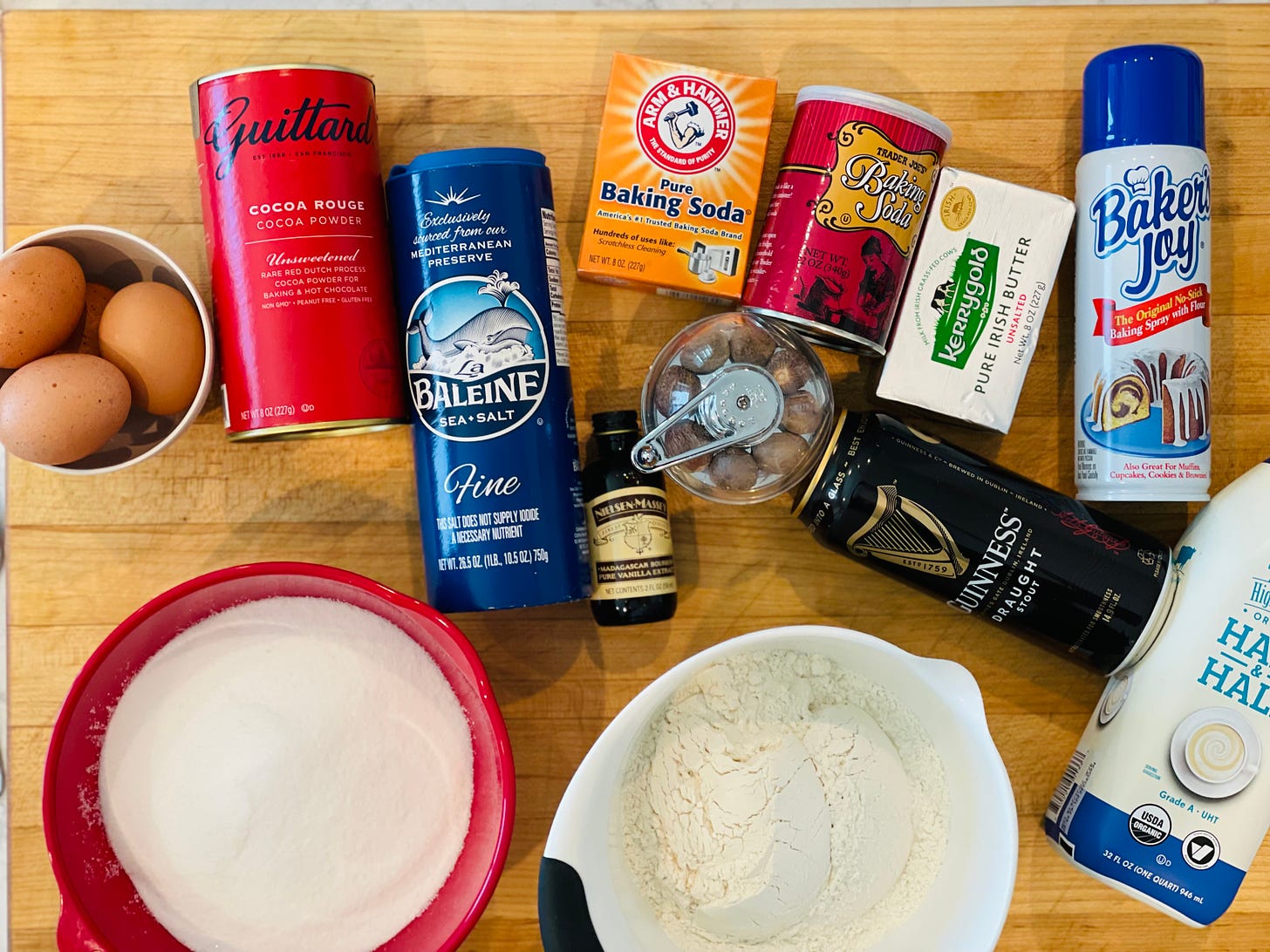

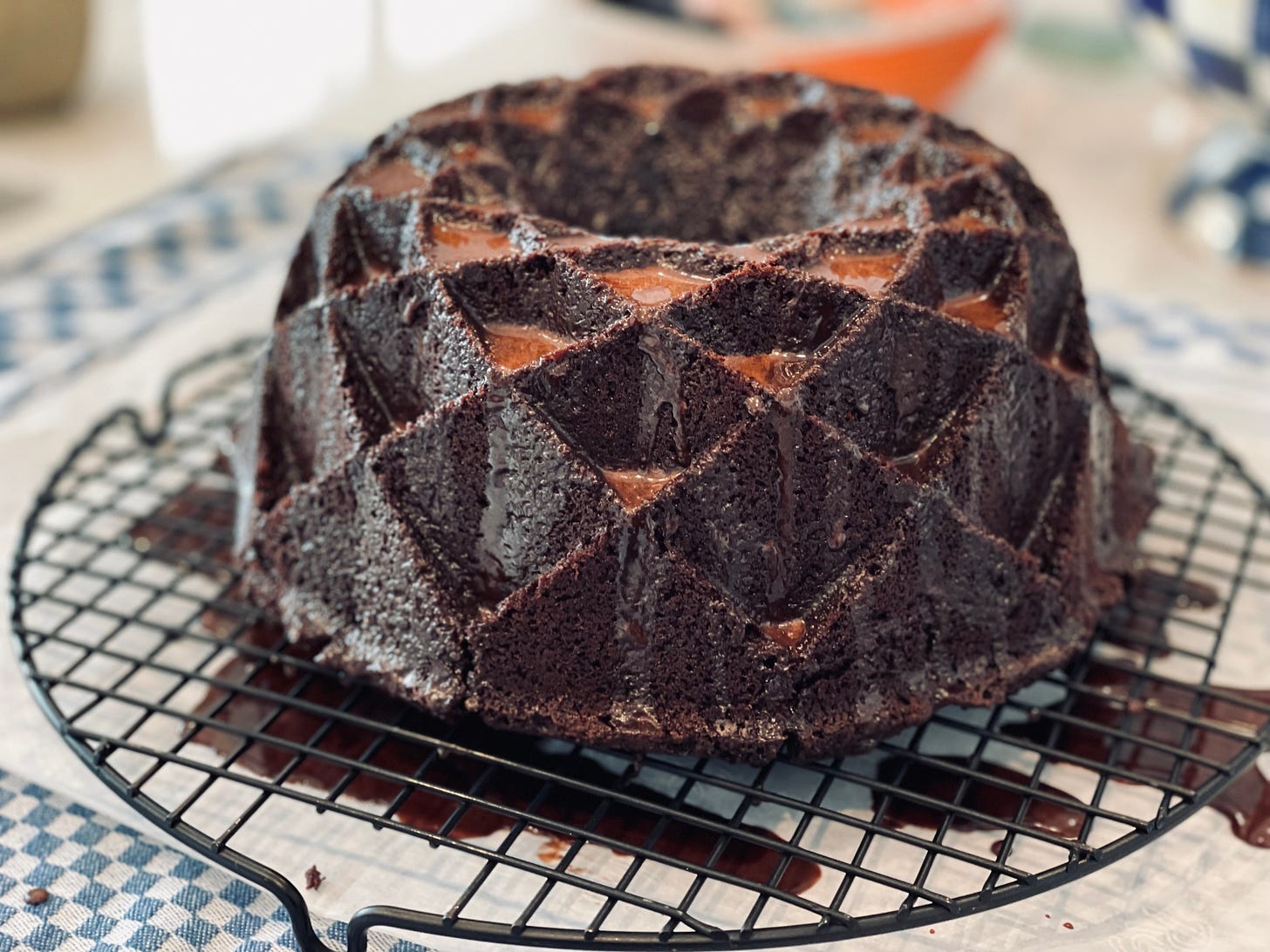
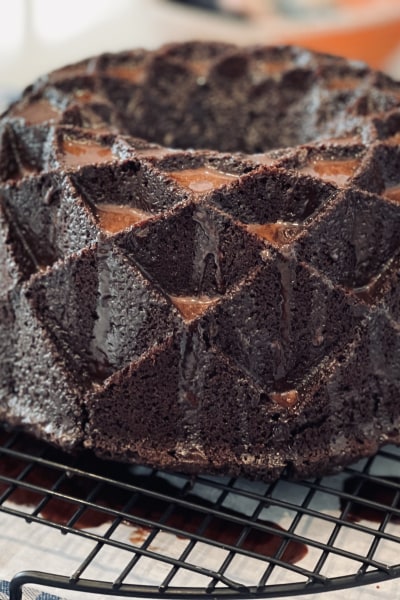
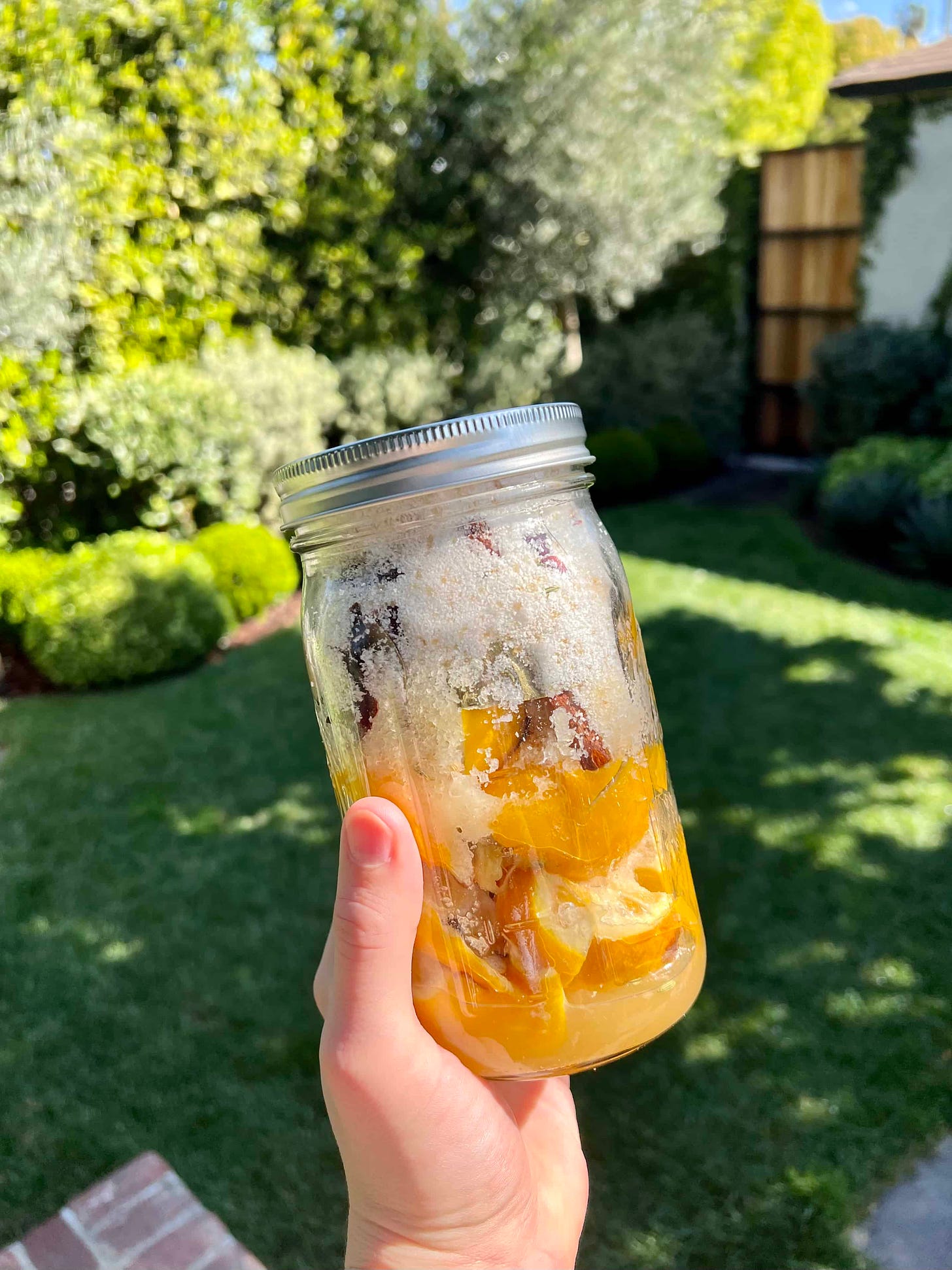
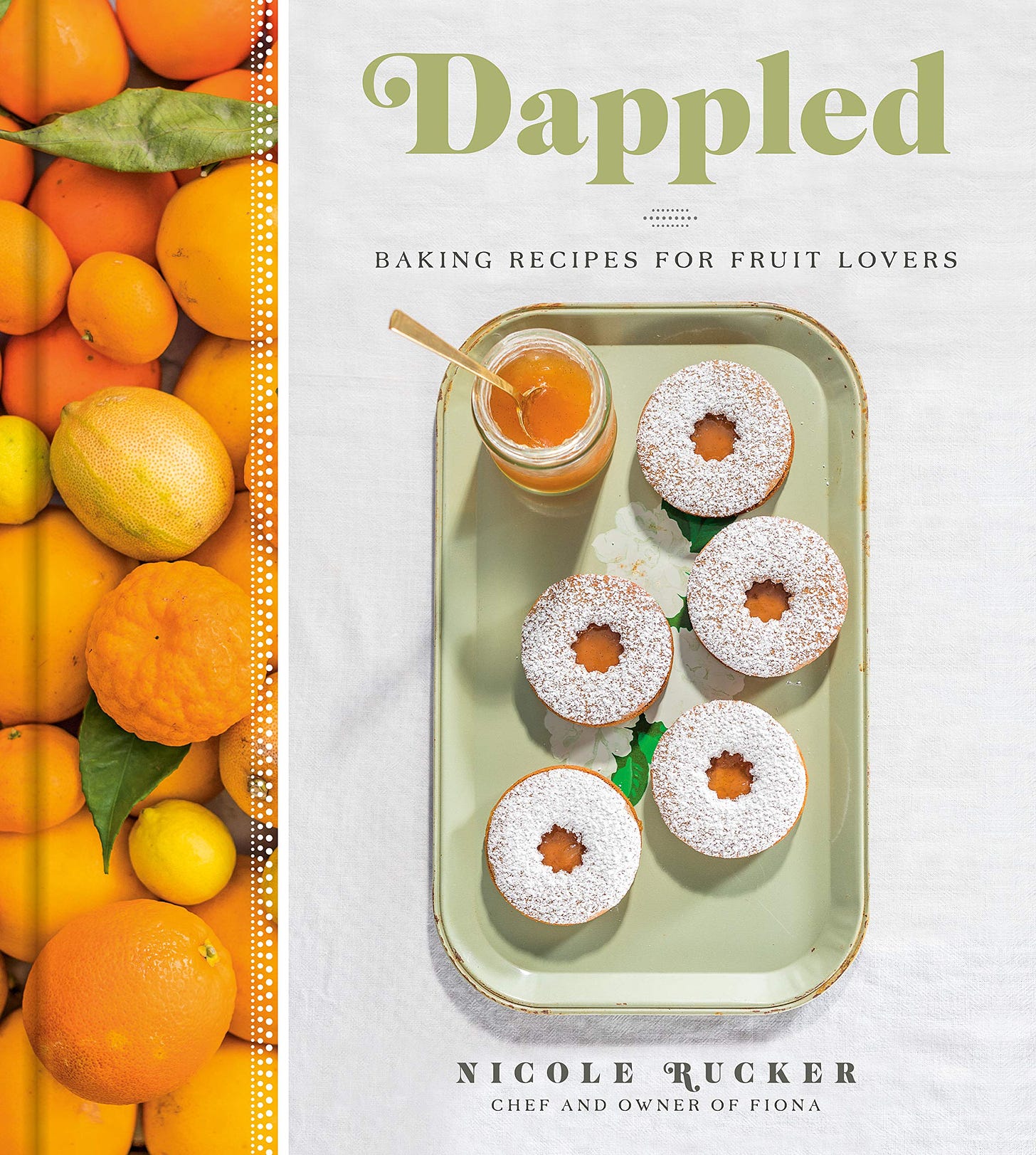
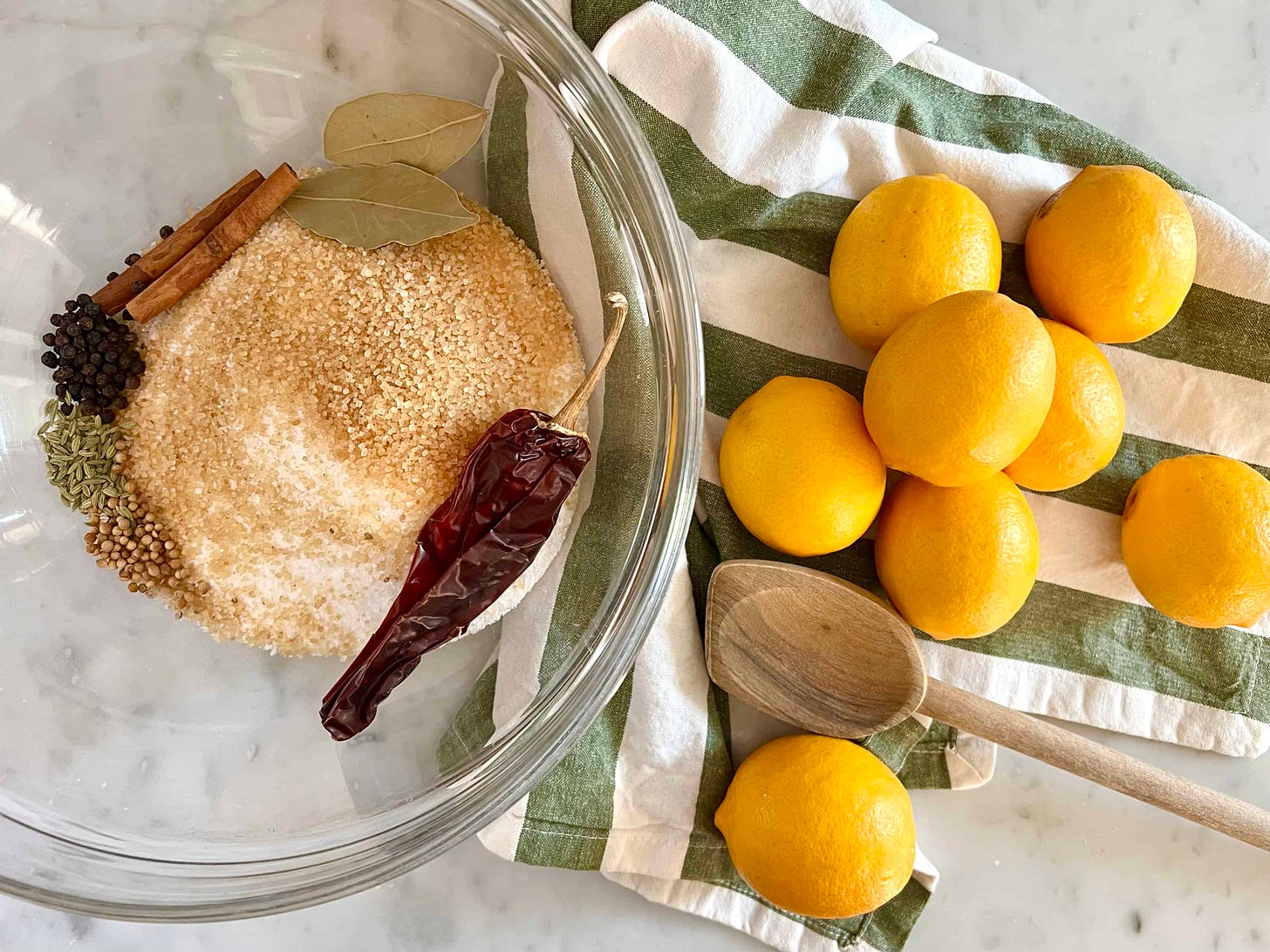
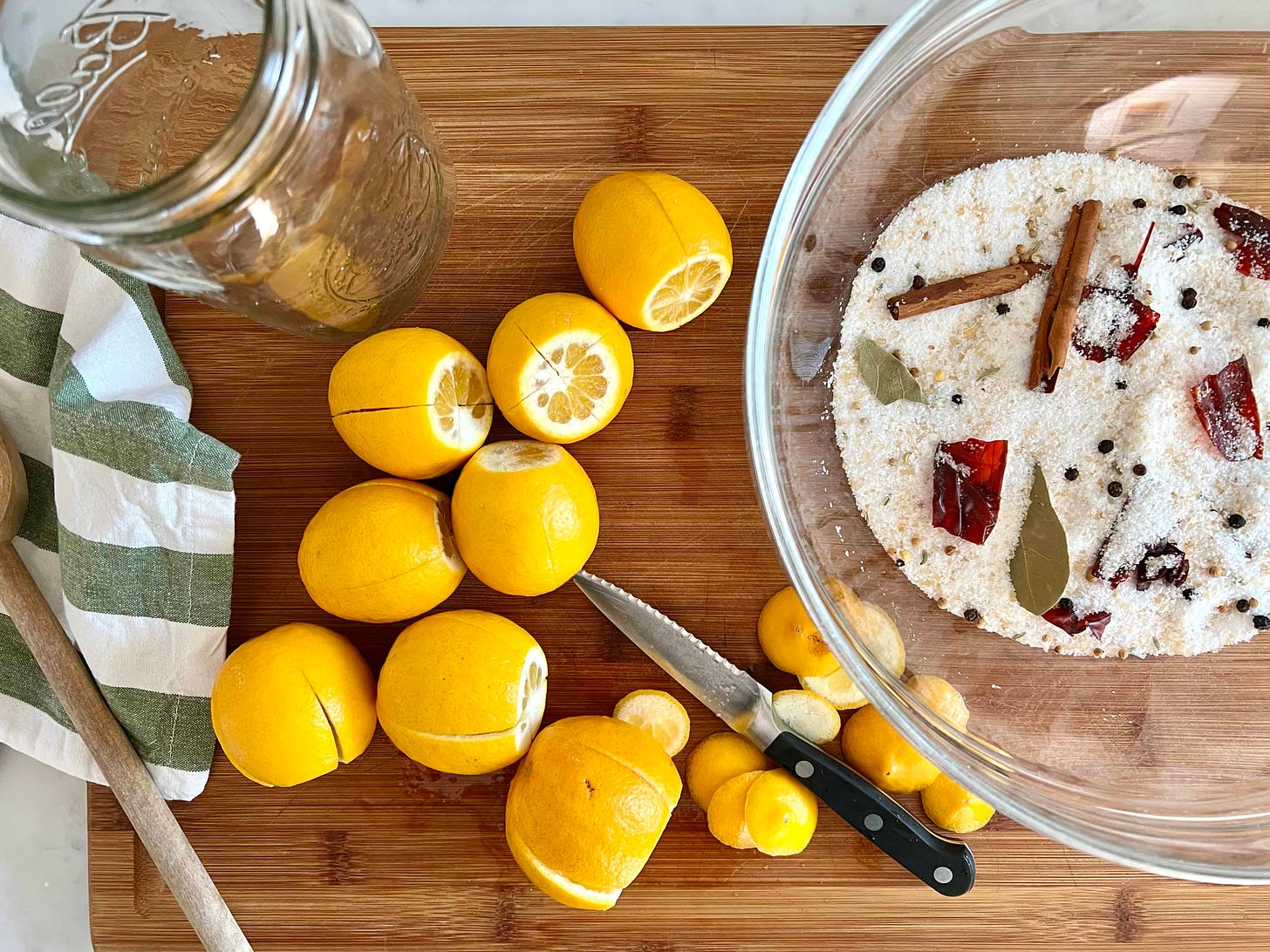
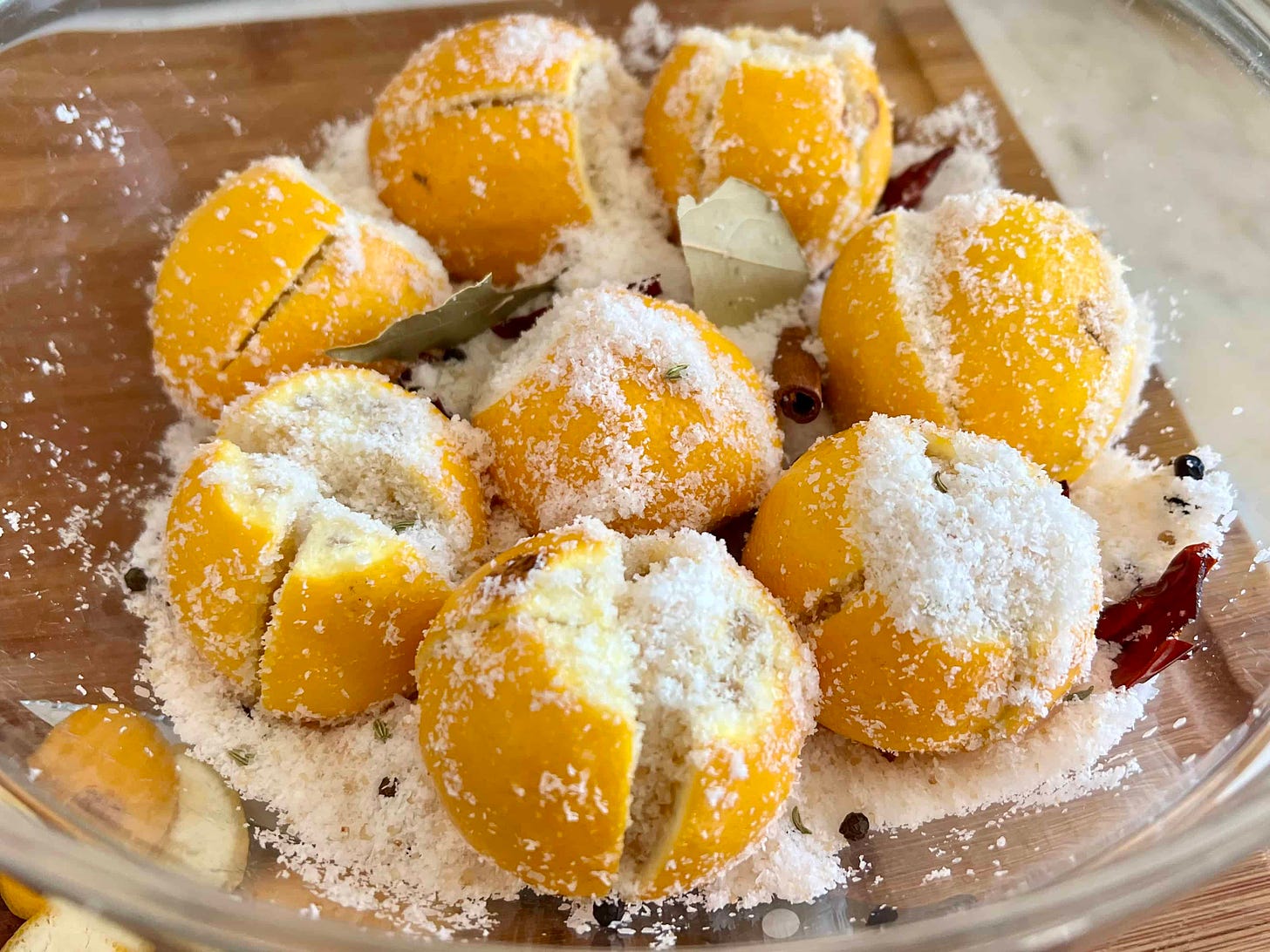
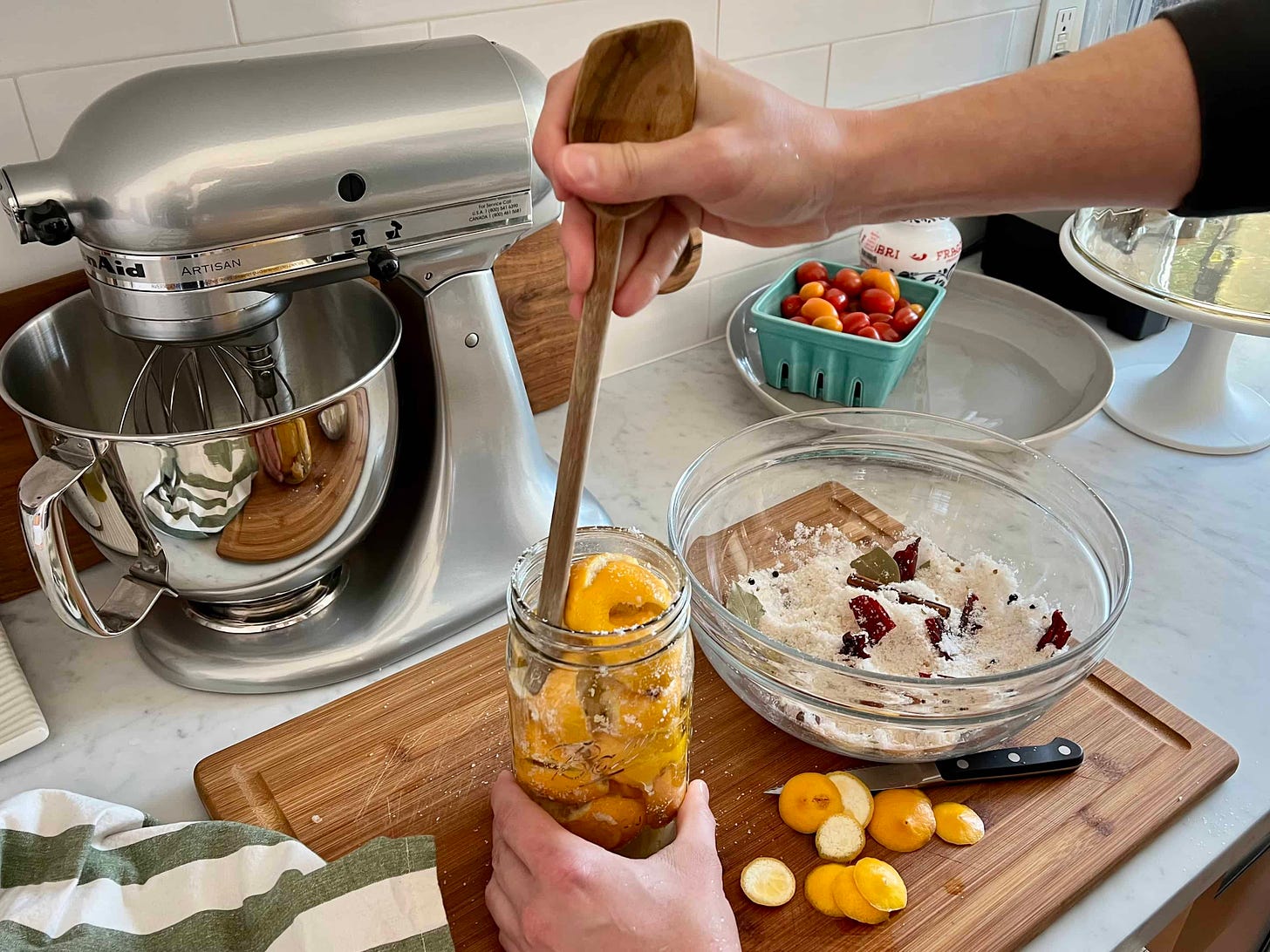
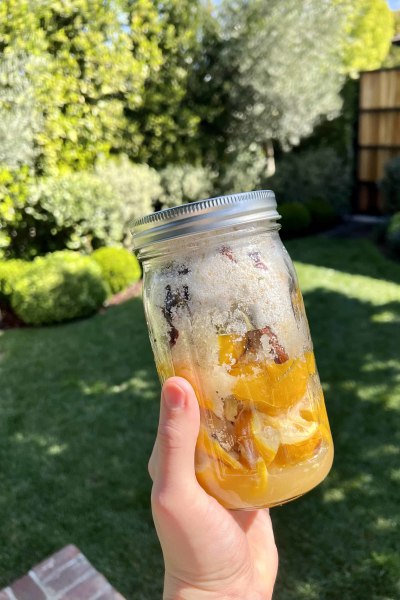
I am going to have to bake this cake!!!